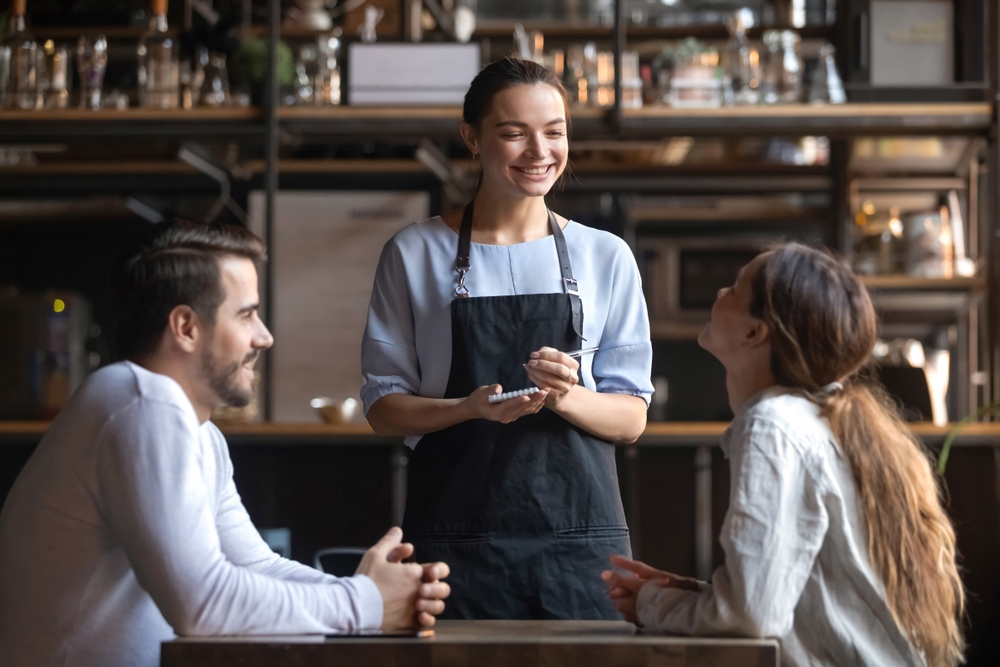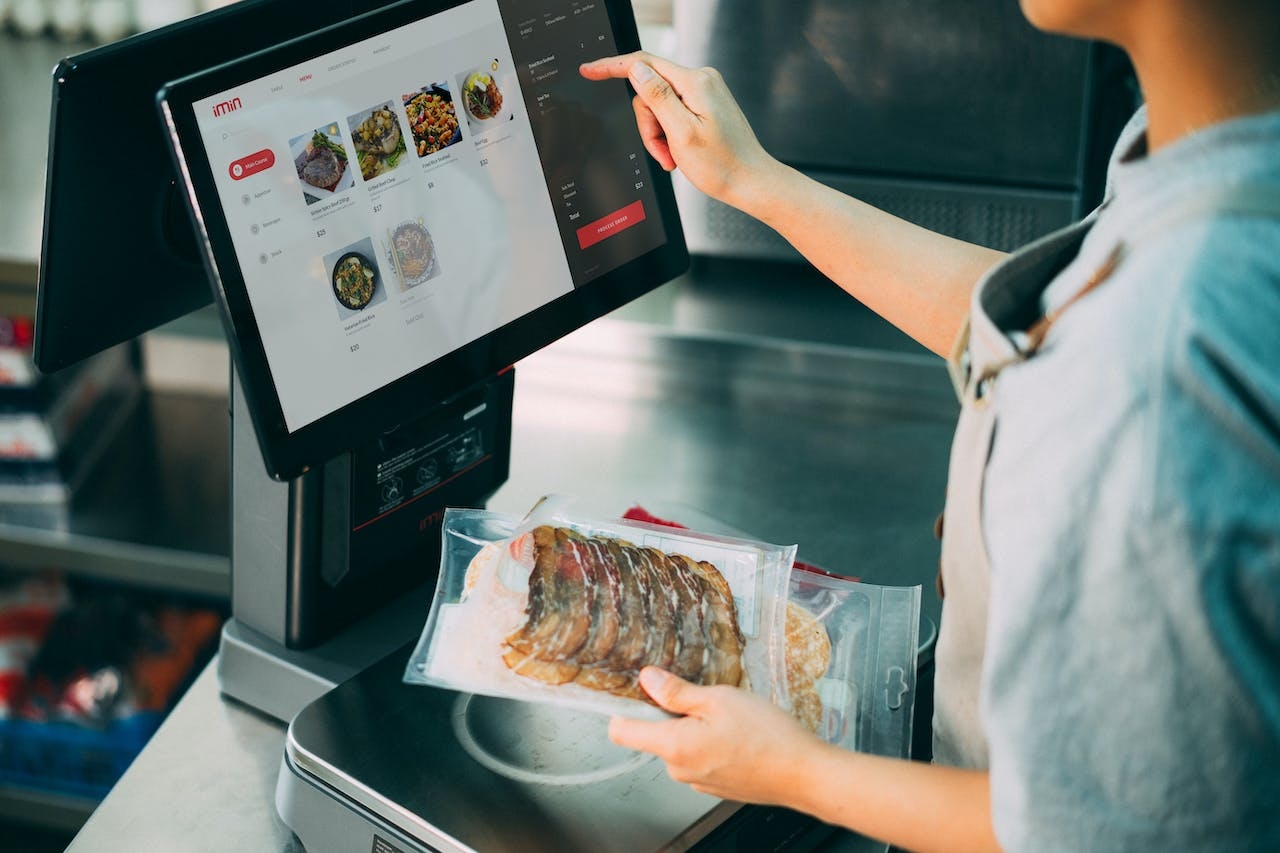Enhancing the Dining Experience: How to Improve Customer Experience in Restaurant
By Nikita Nielsen · 1. March 2024
Discover how to improve the customer experience in your restaurant with our focused guide.
We’ll reveal specific strategies for crafting memorable visits: from training an exceptional staff to leveraging feedback for continual improvement.
Whether it’s a personalised greeting or a seamless payment process, you’ll learn to fine-tune every aspect of your service to craft the standout dining experiences that keep customers coming back.
Key Takeaways
- A memorable dining experience hinges on consistent, high-quality customer service, cleanliness and hygiene standards, and attention to detail, which contributes to customer loyalty and positive word-of-mouth.
- Exceptional customer service in restaurants is driven by well-trained staff empowered to resolve issues, effective communication, and team cohesion, which collectively create a seamless dining experience.
- Restaurants must actively seek, manage, and analyze customer feedback through various channels, including digital surveys and online reviews, to identify improvement areas and enhance the overall dining experience.
Crafting a Memorable Restaurant Customer Experience
 restaurant design
restaurant design
In the fast-paced restaurant industry, an exceptional dining experience is key to success.
The journey towards service excellence begins with an attentive staff, timely food service, and the graceful handling of customer complaints, all of which are fundamental to an exceptional customer experience.
Yet, the consistency of this experience is what truly builds customer loyalty, as it assures guests that their expectations will be met or exceeded each time they visit.
Without exception, high cleanliness and hygiene standards are required, as they greatly influence customer opinions.
It’s the attention to detail that often makes the difference, turning happy customers into vocal ambassadors for your restaurant.
When you exceed expectations consistently, you not only boost revenue through positive word-of-mouth marketing, but also cultivate a loyal customer base drawn to your exceptional service.
First Impressions Count
When a customer steps through your doors, the clock starts ticking on making a lasting impression.
A genuine greeting, complete with a warm smile and direct eye contact, can transform a first-time guest into a repeat customer.
The tone for the entire meal is set the moment they are promptly and courteously seated, receiving immediate attention from your staff.
This initial encounter is powerful; it shapes not only their current visit but also their desire to return, affecting both satisfaction and loyalty.
When customers feel valued from the outset, they’re more likely to overlook small mishaps during their meal and remember the positive aspects of their experience.
It’s these first moments that can either elevate your restaurant’s reputation or hinder it, depending on how guests perceive and recount their experience to others.
Personalized Service
Imagine walking into a restaurant and being greeted by name, or visiting on your birthday to find a complimentary dessert waiting for you. This level of personalized service is not just impressive; it’s expected in today’s market, where 80% of consumers favor companies that offer personalized experiences.
Personalization establishes an emotional bond, giving customers a sense of being understood and cared for, which in turn improves their satisfaction and promotes return visits.
Using guest data, restaurants can address diners by name, remember their preferences, and celebrate special occasions, which fosters loyalty and connection.
Be it a sophisticated CRM system or a reservation software with customer data, customizing the dining experience is instrumental in making customers feel cherished and ensuring their return.
Fine-tuning the Ambiance
 restaurant
restaurant
Ambiance plays a silent yet pivotal role in dining. The right combination of music, lighting, and decor can influence customers’ emotions and their likelihood to revisit your establishment.
Here are some tips to create the perfect ambiance for your restaurant:
- Lighting should create an inviting atmosphere that enhances intimacy
- Music should complement the desired mood without drowning out conversation
- Decor should reflect the theme and style of your restaurant
A unique and consistent ambiance can serve as a differentiator, establishing a brand identity that customers recognize and associate with your restaurant.
The decor of your restaurant, from furniture to artwork, should set the intended tone for the space, influencing not only the dining experience but potentially leading to increased customer spending.
Every element should coalesce to leave a lasting impression on the guest, ensuring their memories of the meal are as much about the environment as they are about the cuisine.
Elevating Service Through Staff Excellence
 smiling waitress
smiling waitress
Behind every great dining experience is an exceptional team. Staff training is crucial to cultivating the competencies needed to deliver top-notch customer service.
Some key strategies for staff training include:
- Providing comprehensive training on menu items, ingredients, and preparation methods
- Conducting role-playing exercises to simulate different customer scenarios and teach staff how to handle them effectively
- Offering ongoing training and development opportunities to keep staff updated on industry trends and best practices
Empowering staff to resolve customer disputes can avert escalation, showcasing the restaurant’s dedication to superior customer service.
Moreover, acknowledging and rewarding staff for outstanding service can keep the team motivated and focused on providing excellent customer service.
Knowledgeable staff who can provide accurate menu recommendations and handle queries effectively ensure a seamless dining experience for the customer.
Effective intra-staff communication is vital for synchronizing swift service and maintaining high customer satisfaction.
Addressing customer concerns promptly and adequately is a key aspect of better customer service, and it’s these interactions that often determine whether a customer will become a loyal patron or a one-time guest.
By focusing on these aspects, restaurants can improve customer service, which goes beyond just good customer service to achieve great customer service.
Empowerment and Training
Empowerment and training go hand in hand in fostering a skilled workforce. Cross-training employees across various roles within the restaurant not only increases staffing flexibility but also equips staff to address a broad range of customer needs effectively.
When staff members are given leadership roles and responsibilities, it instills a sense of purpose and motivation, leading to elevated service quality.
Avoiding micromanagement and trusting staff to perform their duties allows for an environment where innovation and teamwork can thrive.
A mentorship program where seasoned employees guide new hires not only reinforces team solidarity but also ensures consistent service quality across the staff.
Training staff to recognize customer cues and body language empowers them to respond to diner needs with a more personal and attentive approach, going the extra mile for customer satisfaction and to improve restaurant customer service.
Communication Mastery
Masterful communication is the backbone of exceptional customer service.
Staff must be adept in both verbal and non-verbal communication to effectively convey information and understand customer cues, ensuring that customer needs are anticipated and met.
Challenges such as ambient noise, language barriers, and high-pressure situations require staff to be particularly skillful communicators to maintain a positive dining experience.
Regular team briefings are crucial for:
- Equipping staff with up-to-date knowledge on specials, menu changes, and customer preferences
- Allowing for proactive service
- Creating a cohesive team environment
When everyone is on the same page, the likelihood of service mishaps diminishes significantly, and the overall guest experience is enhanced.
Feedback: The Gateway to Improvement
Feedback serves as a compass, directing you towards improvement. Diverse channels such as comment cards, digital surveys, and direct conversations are instrumental in gathering customer feedback.
A Feedback Management App can be a valuable technological tool for collecting and managing this feedback effectively.
This feedback, including customer complaints and reviews, is essential for driving improvements in the guest experience.
Analyzing customer feedback helps restaurants in the following ways:
- Pinpoint specific areas that require attention
- Enhance their services accordingly
- Listen to what customers perceive and expect
- Align their service to meet those expectations
- Enhance customer satisfaction
- Cultivate loyalty, as diners value being listened to and witnessing the implementation of their suggestions.
Actively Seeking Opinions
Proactively soliciting diners’ opinions is an assertive strategy towards customer service.
Methods such as in-person surveys and mobile apps provide invaluable insights into the dining experience from the customer’s perspective.
Open-ended feedback is particularly crucial, as it allows customers to elaborate on their experiences and suggest specific improvements.
Taking customer complaints seriously and responding to them promptly offers vital information for restaurant improvements and demonstrates a commitment to excellent customer service.
Customer satisfaction surveys can be used to evaluate various aspects of the dining experience, including:
- food quality
- service quality
- cleanliness
- ambiance
- value for money
This helps in maintaining high standards and ensuring a consistent dining experience for all guests.
Online Review Management
In today’s digital era, online reviews are an influential means to comprehend guest views on service and food quality.
They reflect the public’s view of the dining experience and are a trusted means of measuring customer satisfaction.
The competitive nature of the restaurant industry makes positive online reviews essential due to the high volume of customers that can generate feedback.
Managing online reviews professionally and promptly builds trust and shows a commitment to resolving customer dissatisfaction.
Professionalism is key🔑; responses must be grammatically correct, polite, and provide explanations for any actions taken to address the feedback.
Implementing technological solutions like a mobile app can enhance a restaurant’s online presence and make it easier to collect and manage reviews in a timely manner.
Analyzing Feedback Trends
Analyzing feedback trends is like deciphering a code; once you understand the pattern, you can unlock improvements that enhance the dining experience.
Here are some steps to help you analyze feedback trends:
- Identify common themes in customer feedback.
- Pinpoint areas in need of improvement based on these themes.
- Determine the root cause of issues.
- Make meaningful changes based on your analysis.
By following these steps, you can effectively analyze feedback trends and make improvements to enhance the dining experience.
Incorporating customer feedback into the restaurant’s operations can provide valuable insights and improve customer satisfaction. Here are some specific aspects to focus on:
- Food temperature
- Freshness
- Flavor
- Presentation
By collecting and analyzing feedback in these areas, restaurants can make targeted improvements and enhance the overall dining experience to improve restaurant customer satisfaction.
Innovations in Customer Convenience
Technological progress has transformed restaurant operations, offering avenues to enhance processes and deliver high-quality service, thus improving the overall customer dining experience.
By integrating various systems and technologies, restaurants gain a holistic view of operations that enhances efficiency and personalizes interactions with guests.
Innovations like POS systems, mobile ordering, and diverse payment methods streamline customer transactions, simplifying the process and making it convenient for guests to engage with the restaurant’s services.
Easy ordering and payment processes improve the overall experience for customers, encouraging them to return.
Streamlined Ordering Systems
 restaurant payment system
restaurant payment system
Modern POS systems are the conductors of the restaurant industry’s orchestra, enhancing efficiency and minimizing errors through features like:
- Live order tracking
- Integration with online ordering platforms and accounting software
- Quick payment processing
- Easier financial management
- Continuous software updates
These systems ensure that restaurants have the most up-to-date tools for service optimization.
Mobile ordering apps and customizable online ordering systems create personalized experiences that boost loyalty and set restaurants apart from competitors.
Tabletop tablets offer an all-in-one solution for ordering, payment, and feedback, further personalizing the dining experience.
Advanced POS systems with inventory tracking ensure a consistent and full menu offering, essential for a smooth restaurant operation.
Payment Flexibility
Offering multiple payment options is like offering a menu for transactions; it caters to the diverse preferences of your customers.
New POS systems can process a broad range of payment methods, including contactless options crucial for quick-service restaurants.
This maximizes conversion rates by allowing customers to complete transactions with their preferred methods.
A variety of payment methods not only improves the overall customer experience by reducing friction at checkout but also appeals to a wider demographic.
When transactions are completed swiftly and conveniently, it leaves a lasting positive impact on the customer’s perception of the restaurant.
Reservation and Waitlist Technologies
Reservation and waitlist technologies ensure a harmonious flow of guests. Reservation systems allow for strategic control over guest seating, avoiding overwhelming front-of-house and kitchen staff.
By forecasting expected guest numbers, restaurants can accurately order food and reduce waste.
Waitlist management tools provide the following benefits:
- Accurate wait times, improving the overall customer experience and perceptions of the restaurant
- Amenities for waiting areas
- Efficient handling of crowds by waitlist management systems, preventing negative customer experiences even during busy periods.
Keeping a few tables unreserved enables restaurants to accommodate unexpected situations such as VIP guests or walk-ins, ensuring that every guest feels valued and taken care of.
Building Lasting Customer Relationships
Cultivating lasting customer relationships is a sign of a successful🏅 restaurant. It’s not just about one-off visits; it’s about creating a community of diners who return time and again.
Consistency in food quality and presentation establishes the groundwork for enjoyable dining experiences, which are crucial for creating a loyal clientele.
Going the extra mile for customers not only creates loyal patrons but also attracts new customers through the most powerful tool of all—word of mouth.
Successful restaurants understand that it’s not just the quality of the food that keeps customers coming back; it’s the feeling of being part of a community that values them.
This is where customer relationship management becomes key, as it encompasses everything from remembering customer preferences to celebrating their milestones, ensuring that each visit is as memorable as the last.
Loyalty Programs
 loyalty program
loyalty program
Implementing a mobile app can boost customer engagement and loyalty by offering rewards for orders placed through the app, encouraging repeat business.
Some benefits of implementing a mobile app for your loyalty program include:
- Offering rewards for orders placed through the app
- Encouraging repeat business
- Allowing customers to collect points with each visit
- Allowing customers to redeem points for rewards
These benefits create an incentive for customers to return and continue engaging with your business.
Tiered loyalty programs motivate customers to visit more frequently and spend more to reach higher levels🔝 of rewards.
Personalizing these programs by recognizing individual preferences significantly enhances the dining experience and drives customer engagement, fostering loyalty that goes beyond a single meal.
Community Engagement
Engaging with the local community can turn a restaurant into a neighborhood staple. Here are some ways to do it:
- Hosting local events or participating in community activities to increase visibility and engagement.
- Partnering with local businesses or charities for collaborative promotions or events to build a positive reputation and encourage community support.
- Offering special discounts or promotions for local residents to drive repeat business and foster loyalty.
These strategies can help you, as a restaurant owner, make your restaurant become an integral part of the community.
Consistent Quality Assurance
A commitment to consistent quality assurance is what distinguishes a good restaurant from a great one.
Creating a culture of continuous learning and daily training can reinforce consistency and quality in service.
Standardized recipes and equipment are crucial for ensuring consistent food quality across different locations, helping to maintain the brand’s reputation for excellence.
Utilizing customer data effectively allows staff to tailor service specifically to guest preferences, adding a personal touch to the dining experience.
Actively seeking and utilizing customer feedback is key to ongoing quality improvement; it should be used to refine the menu and recipe offerings, ensuring that every dish meets the high standards that customers have come to expect.
Summary
From making a strong💪 first impression to building lasting customer relationships, each aspect plays a critical role in crafting an unforgettable dining experience.
Every interaction, every dish, and every gesture contributes to the story your customers will share.
So, aim for perfection in every aspect, and watch as your guests evolve from occasional visitors to ardent enthusiasts of your culinary offerings.
By attending to every detail, you can turn your restaurant into a destination that guests recommend with enthusiasm, and where every visit is an event in itself.
Frequently Asked Questions
How can restaurants improve customer experience?
Restaurants can improve customer experience by using technology and implementing a loyalty program to encourage guests to return and feel more invested in the restaurant. This can help develop a closer relationship with customers.
How do you ensure customer satisfaction in a restaurant?
To ensure customer satisfaction in your restaurant, focus on providing great atmosphere, small surprises, cleanliness, excellent customer service, and ensure your staff is happy, which leads to happy employees and customers alike. Additionally, you can improve customer satisfaction by focusing on service, reducing wait times, setting expectations, creating a comfortable atmosphere, offering a variety of options, providing promotions and collecting and listening to feedback from guests.
How can technology improve the restaurant customer experience?
By streamlining ordering and payment processes, providing flexible payment options, and improving reservation and waitlist management, technology can contribute to a more convenient and personalized dining experience for restaurant customers.
How can restaurants effectively manage online reviews?
Restaurants can effectively manage online reviews by responding professionally and promptly, addressing negative feedback respectfully, and leveraging positive reviews to build trust and encourage more feedback.

